
For almost 100 years, Hearst Castle has towered over California's Central Coast, surrounded by 128 square miles of privately owned ranch land. It may never be otherwise.
Visitors to the castle, now a state park, enjoy the same unobstructed views of the Pacific Ocean that newspaper magnate William Randolph Hearst enjoyed with his Hollywood friends. That view is the 82,000-acre Hearst Ranch, a habitat for 1,000 plant and wildlife species and the nation's largest producer of grass-fed beef, delivering more than a million pounds a year to Whole Foods.
"This property is a showpiece, it's kind of the hood ornament on our Mercedes, so to speak," said Steve Hearst, William Randolph Hearst's great-grandson who now runs the ranch, which is valued at $240 million.
What's really improbable is the fact that it looks the way it still does today. The fact that we look down at old California instead of a developed California really is quite remarkable.Ty Smithchief of museum interpretation, Hearst Castle
The "hood ornament" could have looked very different. For decades, there were plans to develop the ranch and put in homes, golf courses, and a community of 60,000 people. The plans were unpopular, and when Steve Hearst took over the ranch in the 1990s, he discovered a way to keep the ranch and make some money. It's been 10 years since he sold the development rights for $95 million to the California Rangeland Trust, a nonprofit that uses public and private money to voluntarily take away development rights from ranchers in what's called a conservation easement.
"When you do a conservation easement, it's a fraction of the cost of what it would cost the government to protect it outright," said Nita Vail, CEO of the California Rangeland Trust. "You have a landowner that manages the land, it stays on the tax rolls, you have a private steward. ... It's really a win-win."
In exchange for $95 million, Hearst gave 13 miles of coastline to the state—which includes breeding grounds for elephant seals—and the company promised it will do no more construction on the ranch, other than about two dozen private residences for 60-odd Hearst relatives. None of those houses will be visible from Highway 1 or the castle.
"Nobody in the mother company, the mother ship, really knew what we were doing," Hearst said about broaching the topic with the Hearst board of selling development rights. "They said it sounds like smoke and mirrors, and I said it's absolutely not, it's real."
Read MoreAmid drought, some California farmers in 'survival mode'
His rights sale is by far the most extreme example of selling development rights to a trust, but dozens of other smaller California ranches have sold rights to 300,000 acres of land. Similar trusts aimed at cattle ranchers exist in seven other states.
"It allows us to pull some money out of the ranch when, right now, it's not a great time to be a rancher, it's financially difficult to do that," said Daniel Sinton is a fifth-generation cattle ranch in Shandon, California, and a Rangeland Trust board member.
Steve Hearst didn't have to sell, but it seemed like a great solution. "What's different about this property owner than others is that we did it voluntarily," he said. "Normally people are dealing with land trusts like this because they have a tax issue to deal with. Dad dies and now you owe 50 percent of what you own to the government, and a lot of them have to sell the rights."
In the meantime, Hearst continues to look for ways to make money on the ranch without violating the agreement he made with the trust. With a relentless California drought in its fourth year, he has scaled back his cattle operation by half, and he started paying $80,000 a month to bring in a mixture of grass to feed his remaining cows. When Whole Foods found out about his moves, Hearst said the company president approached him to split the cost.
"They invited a price increase because they understood that everything that they do and what we do has to be sustainable," Hearst said. "What a partner to have to say, 'Look, if it's costing you more, we'll pay more.'"
Read MoreDry wine: The plight of California grape growers
While Hearst won't divulge exactly how much Whole Foods pays for his high-end beef—"nobody to my knowledge has ever received the kind of money we're receiving for beef"—the cattle operation isn't always profitable. So Hearst is using an adjacent ranch not covered by the trust to let First Solar build a solar array to power Apple's new headquarters in Cupertino. "When I found out they were hunting for power, I said, 'Hey, we've got a solar field.'"
There are some critics of Hearst's $95 million deal to never develop the main ranch, though criticism centers on whether there's enough oversight to make sure the land is being managed in a sustainable way. No one has argued about using funds to keep this part of California untouched.
"What's really improbable is the fact that it looks the way it still does today," said Ty Smith, who is chief of museum interpretation at Hearst Castle. "The fact that we look down at old California instead of a developed California really is quite remarkable."
Read MoreWhere's the beef? Restaurants flock to chicken
It wasn't easy getting there, however. Hearst said practically every environmental and governmental group wanted a say in the negotiations for his rights sale. It took five years and millions of dollars to complete the deal. "It was such a pain—my God, this is not for sissies," he said.
In hindsight, it made perfect sense both financially and environmentally for him. "I gave away development rights that ... while valuable, I think it's more valuable the way it is," he said, overlooking the Pacific in the shadow of the castle pool where he played as a child. "We got to sell it and keep it."


